
Artsakh was the tenth province (nahang) of the Kingdom of Armenia from c. 189 BC until 387 AD, when it was made part of Caucasian Albania, a subject principality of the Sasanian Empire, following the Peace of Acilisene. From the 7th to 9th centuries, it fell under Arab control. In 821, it formed the Armenian principality of Khachen and around the year 1000 was proclaimed the Kingdom of Artsakh, one of the last medieval eastern Armenian kingdoms and principalities to maintain its autonomy following the Turkic invasions of the 11th to 14th centuries.
The Armenian nobility was a class of persons which enjoyed certain privileges relative to other members of society under the laws and customs of various regimes of Armenia. Governments which recognized or conferred nobility were the Kingdom of Van, Satrapy of Armenia, Kingdom of Armenia, Bagratid Kingdom of Armenia (885–1045) and the Armenian Kingdom of Cilicia (1198–1375). The Armenian kingdoms of Vanand (963–1065), Syunik (987–1170), and Lori (978–1113) had a system of nobility that was similar to the nobility of Cilicia.
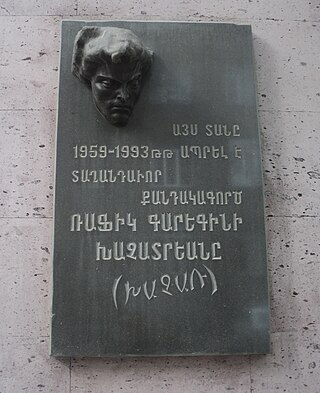
Rafik Khachatryan was an Armenian sculptor. He was the father of Garegin Khachatryan (1975–1995).
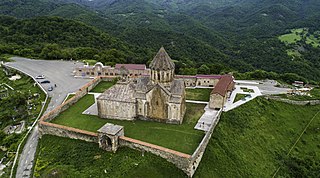
Gandzasar is a 13th-century Armenian Apostolic cathedral near the village of Vank in the Kalbajar District of Azerbaijan. It has historically been the most important church of Artsakh (Nagorno-Karabakh) since its foundation. One of the finest pieces of Armenian architecture of the mid-1200s, the building is best known among scholars for its richly decorated dome.

Мelik was a hereditary Armenian noble title used in Eastern Armenia from the Late Middle Ages until the nineteenth century. The meliks represented some of the last remnants of the old Armenian nobility. The most prominent and powerful meliks were those of Karabagh (Artsakh) and Syunik, which ruled autonomous or semi-autonomous principalities known as melikdoms under Iranian suzerainty. Meliks also existed in Yerevan, Nakhichevan, Sevan, Lori, Northwestern Persia, and other areas, although outside of Karabagh and Syunik most were merely hereditary leaders of local Armenian communities, not rulers of principalities.
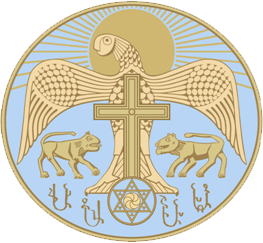
Hasan-Jalalyan was a medieval Armenian dynasty that ruled over parts of the South Caucasus. From the early thirteenth century, the family held sway in Khachen in what are now the regions of lower Karabakh, Nagorno-Karabakh, and Syunik in modern Armenia. The family was founded by Hasan-Jalal Dawla, an Armenian feudal prince from Khachen. The Hasan-Jalalyans maintained their autonomy over the course of several centuries of nominal foreign domination by the Seljuk Turks, Persians and Mongols. They, along with the other Armenian princes and meliks of Khachen, saw themselves as holding the last bastion of Armenian independence in the region.

Husulu, historically also known as Kashataghk is a village in the Lachin District of Azerbaijan, located close to the villages of Malıbəy (Melikashen), Qarıqışlaq (Tandzut) and Ağoğlan. Kashataghk/Husulu is known for being the first capital of the Armenian Meliktom of Kashatagh.

Kusapat or Chiragly is a village in the Tartar District of Azerbaijan. Prior to the 2023 Azerbaijani offensive, The village has an ethnic Armenian-majority population, and also had an Armenian majority in 1989.

Martakert or Aghdara is a town in the Tartar District of Azerbaijan, in Nagorno-Karabakh. It was formerly controlled by the de facto breakaway Republic of Artsakh as the administrative capital of its Martakert Province before the 2023 Azerbaijani offensive. The town has an ethnic Armenian-majority population, and also had an Armenian majority in 1989. The town underwent heavy destruction by Azerbaijani forces while under their control during the First Nagorno-Karabakh War.
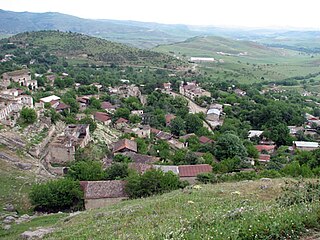
Tugh or Togh is a village in the Khojavend District of Azerbaijan, in the region of Nagorno-Karabakh. The village had a mixed Armenian-Azerbaijani population before the First Nagorno-Karabakh War, the Azerbaijani inhabitants fled the fighting in 1991, and the Armenian population fled the village during the 2020 Nagorno-Karabakh war.

Zar is a village in the Kalbajar District of Azerbaijan.
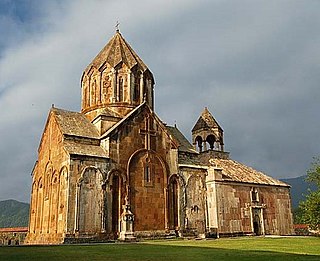
Culture of Artsakh includes artifacts of tangible and intangible culture that has been historically associated with Artsakh in the Southern Caucasus, controlled by Azerbaijan. These include monuments of religious and civil architecture, memorial and defense structures, and various forms of art.

The Kingdom of Artsakh was a medieval dependent Armenian kingdom on the territory of Syunik and Artsakh provinces, Gardman canton of Utik province, Mazaz and Varazhnunik canton of Ayrarat province. Contemporary sources referred to it as the Khachen. However, because the domain of Khachen during the reign of Prince Hasan Jalal included the entire territory of the modern Nagorno Karabakh Republic plus many contiguous lands to its west, south and north, his principality was often called the Kingdom of Artsakh. The royal house of Khachen was a cadet branch of the ancient Syunid dynasty and was named Khachen, after its main stronghold. Hasan-Jalal traced his descent to the Armenian Aranshahik dynasty, a family that predated the establishment of the Parthian Arsacids in the region.
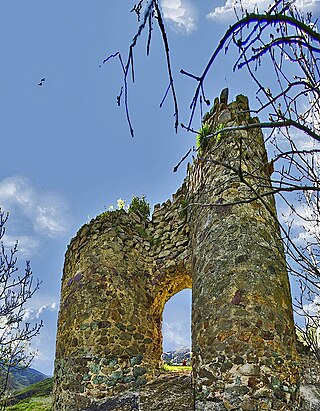
Handaberd, also known as Lekh Castle or Lev Castle, is a 9th-century fortress located in the Kalbajar District of Azerbaijan, near the villages of Lev and Knaravan, on the right bank of the Levçay River. It was built by Atrnerseh I, ruler of the Armenian Principality of Khachen, who resided there.
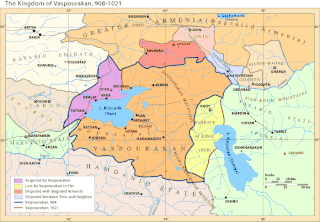
The Kingdom of Vaspurakan was a medieval Armenian kingdom centered on Lake Van, located in what is now eastern Turkey and northwestern Iran. It was named after Vaspurakan, a province of historic Greater Armenia. Ruled by the Artsruni dynasty, it competed and cooperated with the Bagratuni-ruled Kingdom of Armenia for a little over a century until its last king ceded the kingdom to the Byzantine Empire in 1021.

The Five Melikdoms of Karabakh, also known as Khamsa Melikdoms, were Armenian feudal entities on the territory of modern Nagorno-Karabakh and neighboring lands, from the dissolution of the Principality of Khachen in the 15th century to the abolition of ethnic feudal entities by the Russian Empire in 1822.

Vank or Vangli is a village in the Kalbajar District of Azerbaijan, in the region of Nagorno-Karabakh. The village had an Armenian majority in 1989. The 13th-century Gandzasar Monastery, and the 9th-century Khokhanaberd fortress are located near Vank.
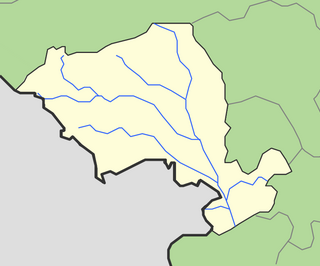
The Melikdom of Kashatagh was an Armenian melikdom (principality) which existed in the 15th–18th centuries. It was located along the Hakari River, on the southeastern section of the modern border of Armenia and Azerbaijan. The residences of the meliks were located in the villages of Kashataghk and Khnatsakh, in the west of the present Lachin District of Azerbaijan and the east of the present Syunik region of Armenia respectively.
Melik Shahnazar II was the melik of Varanda, one of the five Melikdoms of Karabakh, in the 18th century. He is a controversial figure in Armenian history, whose actions contributed significantly to the demise of the Armenian Melikdoms of Artsakh.
The Melikdom of Varanda was one of the five Armenian melikdoms of the Karabakh region. It encompassed Varanda, a district located in the southeastern part of Karabakh.



















